Abstract
To improve the mitigation of seismic disasters in the Xinjiang region, the peak displacement (Pd) and the period parameter (τc) widely used in magnitude estimation for earthquake early warning systems (EEWSs) were investigated in this study. Based on 331 vertical strong-motion records from 58 earthquakes that occurred in the Xinjiang region between 2007 and 2015, we established and evaluated the magnitude-scaling relationships for the two parameters measured from the first 3 s after the P-wave arrival. The calibrations show that both Pd and τc are correlated with the earthquake magnitude within the magnitude range of the study dataset. The linear slope of the Pd–magnitude relationship in this study is lower than those observed in other regions. The τc parameter shows a consistent increasing trend compared with other studies; however, it yields a large uncertainty in the magnitude estimates using a single station. The reliability of the established relationships is evaluated with two earthquakes from the same region, and the results show that a robust magnitude estimate can be obtained when the closest three seismological stations are used. Our study offers insight into the feasibility of an EEWS in the Xinjiang region.











Similar content being viewed by others
Data availability
All data generated or analyzed during this study are available in the Supplementary Information files.
References
Alcik H, Ozel O, Apaydin N, Erdik M (2009) A study on warning algorithms for Istanbul earthquake early warning system. Geophys Res Lett 36. https://doi.org/10.1029/2008gl036659
Allen RV (1978) Automatic earthquake recognition and timing from single traces. Bull Seismol Soc Am 68:1521–1532
Allen R (1982) Automatic phase pickers: their present use and future prospects. Bull Seismol Soc Am 72:S225–S242
Allen RM, Kanamori H (2003) The potential for earthquake early warning in Southern California. Science 3:685–848
Allen RM, Gasparini P, Kamigaichi O, Böse M (2009) The status of earthquake early warning around the world: an introductory overview. Seismol Res Lett 80:682–693. https://doi.org/10.1785/gssrl.80.5.682
Böse M, Ionescu C, Wenzel F (2007) Earthquake early warning for Bucharest, Romania: Novel and revised scaling relations. Geophysical Research Letters 34 https://doi.org/10.1029/2007gl029396
Brown HM, Allen RM, Hellweg M, Khainovski O, Neuhauser D, Souf A (2011) Development of the ElarmS methodology for earthquake early warning: Realtime application in California and offline testing in Japan. Soil Dyn Earthq Eng 31:188–200. https://doi.org/10.1016/j.soildyn.2010.03.008
Carranza M, Buforn E, Zollo A (2015) Testing the earthquake early-warning parameter correlations in the southern Iberian Peninsula. Pure Appl Geophys 172:2435–2448. https://doi.org/10.1007/s00024-015-1061-6
Colombelli S, Amoroso O, Zollo A, Kanamori H (2012) Test of a threshold-based earthquake early warning using Japanese data. Bull Seismol Soc Am 102:1266–1275. https://doi.org/10.1785/0120110149
Colombelli S, Emolo A, Zollo A (2014) A duration magnitude scale for the irpinia seismic network, Southern Italy. Seismol Res Lett 85(1):98–107
Espinosa-Aranda JM, Cuellar A, Garcia A, Ibarrola G, Islas R, Maldonado S, Rodriguez FH (2009) Evolution of the Mexican Seismic Alert System (SASMEX). Seismol Res Lett 80:694–706. https://doi.org/10.1785/gssrl.80.5.694
Heidari R, Shomali Z-H, Ghayamghamian MR (2013) Magnitude-scaling relations using period parameters τc and τpmax, for Tehran region, Iran. Geophys J Int 192:275–284. https://doi.org/10.1093/gji/ggs012
Hoshiba M, Kamigaichi O, Saito M (2008) Earthquake early warning starts nationwide in Japan, EOS, Transactions. Am Geophys Union 89:73–80. https://doi.org/10.1029/2008EO080001
Hsiao N-C, Wu Y-M, Shin T-C, Zhao L, Teng T-L (2009) Development of earthquake early warning system in Taiwan. Geophys Res Lett 36. https://doi.org/10.1029/2008gl036596
Huang PL, Lin TL, Wu YM (2015) Application of τc*Pd in earthquake early warning. Geophys Res Lett 42:1403–1410. https://doi.org/10.1002/2014gl063020
Ionescu C, Böse M, Wenzel F, Marmureanu A, Grigore A, Marmureanu G (2007) An early warning system for deep Vrancea (Romania) earthquakes. In: Gasparini P, Manfredi G, Zschau J (eds) Earthquake early warning systems. Springer, Berlin Heidelberg, Berlin, Heidelberg, pp 343–349. https://doi.org/10.1007/978-3-540-72241-0_17
Kanamori H (2005) Real-time seismology and earthquake damage mitigation. Annu Rev Earth Planet Sci 33:195–214. https://doi.org/10.1146/annurev.earth.33.092203.122626
Lancieri M, Fuenzalida A, Ruiz S, Madariaga R (2011) Magnitude scaling of early-warning parameters for the Mw 7.8 Tocopilla, Chile, earthquake and its aftershocks. Bull Seismol Soc Am 101:447–463. https://doi.org/10.1785/0120100045
Li H, Zhang J, Tang Y (2017) Testing earthquake early warning parameters, τpmax, τc, and Pd, for rapid magnitude estimation in the Sichuan, China, Region. Bull Seismol Soc Am 107:1439–1450. https://doi.org/10.1785/0120160386
Mittal H, Wu Y-M, Sharma ML, Yang BM, Gupta S (2019) Testing the performance of earthquake early warning system in northern India. Acta Geophysica 67:59–75. https://doi.org/10.1007/s11600-018-0210-6
Nakamura Y (1988) On the urgent earthquake detection and alarm system (UrEDAS). Proc. of Ninth World Conference on Earthquake Engineering, Tokyo, Japan, 2–9 august 1988, Vol. VII, 673–678
Nazeri S, Shomali ZH, Colombelli S, Elia L, Zollo A (2017) Magnitude estimation based on integrated amplitude and frequency content of the initial P wave in earthquake early warning applied to Tehran, Iran. Bull Seismol Soc Am 107:1432–1438. https://doi.org/10.1785/0120160380
Park Y, Park S-C, Kim K-H, Park M, Lee J (2010) Magnitude scaling relationships from the first 3 s of P-wave arrivals in South Korea. J Seismol 14:761–768. https://doi.org/10.1007/s10950-010-9198-3
Peng C, Yang J, Xue B, Zhu X, Chen Y (2014) Exploring the feasibility of earthquake early warning using records of the 2008 Wenchuan earthquake and its aftershocks. Soil Dyn Earthq Eng 57:86–93. https://doi.org/10.1016/j.soildyn.2013.11.005
Renate Hartog J, Kress VC, Malone SD, Bodin P, Vidale JE, Crowell BW (2016) Earthquake early warning: ShakeAlert in the Pacific Northwest. Bull Seismol Soc Am 106:1875–1886. https://doi.org/10.1785/0120150261
Sheen DH, Park JH, Chi HC, Hwang EH, Lim IS, Seong YJ, Pak J (2017) The first stage of an earthquake early warning system in South Korea. Seismol Res Lett 88:1491–1498. https://doi.org/10.1785/0220170062
Tsang LLH, Allen RM, Wurman G (2007) Magnitude scaling relations from P-waves in southern California. Geophys Res Lett 34. https://doi.org/10.1029/2007gl031077
Wang S, Yu Y (2009) Research on empirical relationship of earthquake magnitude scales and its influence on seismicity parameters. Technology for Earthquake Disaster Prevention 4:141–149 (in Chinese)
Wang W, Ni S, Chen Y, Kanamori H (2009) Magnitude estimation for early warning applications using the initial part of P waves: a case study on the 2008 Wenchuan sequence. Geophys Res Lett 36. https://doi.org/10.1029/2009GL038678
Weber E, Iannaccone G, Zollo A, Bobbio A, Cantore L, Corciulo M, Convertito V, di Crosta M, Elia L, Emolo A, Martino C, Romeo A, Satriano C (2007) Development and testing of an advanced monitoring infrastructure (ISNet) for seismic early-warning applications in the Campania region of southern Italy. In: Gasparini P, Manfredi G, Zschau J (eds) Earthquake early warning systems. Springer, Berlin Heidelberg, Berlin, Heidelberg, pp 325–341. https://doi.org/10.1007/978-3-540-72241-0_16
Wu YM, Kanamori H (2005a) Experiment on an onsite early warning method for the Taiwan early warning system. Bull Seismol Soc Am 95:347–353. https://doi.org/10.1785/0120040097
Wu YM, Kanamori H (2005b) Rapid assessment of damage potential of earthquakes in Taiwan from the beginning of P waves. Bull Seismol Soc Am 95:1181–1185. https://doi.org/10.1785/0120040193
Wu YM, Kanamori H (2008a) Development of an earthquake early warning system using real-time strong motion signals. Sensors (Basel) 8:1–9. https://doi.org/10.3390/s8010001
Wu YM, Kanamori H (2008b) Exploring the feasibility of on-site earthquake early warning using close-in records of the 2007 Noto Hanto earthquake. Earth, Planets and Space 60:155–160. https://doi.org/10.1186/BF03352778
Wu Y-M, Zhao L (2006) Magnitude estimation using the first three seconds P-wave amplitude in earthquake early warning. Geophys Res Lett 33. https://doi.org/10.1029/2006gl026871
Wu Y-M, Yen H-Y, Zhao L, Huang B-S, Liang W-T (2006) Magnitude determination using initial P waves: a single-station approach. Geophys Res Lett 33. https://doi.org/10.1029/2005gl025395
Wu YM, Kanamori H, Allen RM, Hauksson E (2007) Determination of earthquake early warning parameters, τc and Pd, for southern California. Geophys J Int 170:711–717. https://doi.org/10.1111/j.1365-246X.2007.03430.x
Wurman G, Allen RM, Lombard P (2007) Toward earthquake early warning in northern California. J Geophys Res 112. https://doi.org/10.1029/2006jb004830
Xu Y, Liu FT, Liu JH (2000) Crustal structure and tectonic environment of strong earthquakes in the Tianshan earthquake belt. Chin J Geophys 43:184–193. https://doi.org/10.1002/cjg2.28
Zhang H, Jin X, Wei Y, Li J, Kang L, Wang S, Huang L, Yu P (2016) An earthquake early warning system in Fujian, China. Bull Seismol Soc Am 106:755–765. https://doi.org/10.1785/0120150143
Ziv A (2014) New frequency-based real-time magnitude proxy for earthquake early warning. Geophys Res Lett 41:7035–7040. https://doi.org/10.1002/2014gl061564
Zollo A, Lancieri M, Nielsen S (2006) Earthquake magnitude estimation from peak amplitudes of very early seismic signals on strong motion records. Geophys Res Lett 33. https://doi.org/10.1029/2006gl027795
Zollo A, Iannaccone G, Lancieri M, Cantore L, Convertito V, Emolo A, Festa G, Gallovič F, Vassallo M, Martino C, Satriano C, Gasparini P (2009) Earthquake early warning system in southern Italy: methodologies and performance evaluation. Geophys Res Lett 36. https://doi.org/10.1029/2008gl036689
Zollo A, Amoroso O, Lancieri M, Wu Y-M, Kanamori H (2010) A threshold-based earthquake early warning using dense accelerometer networks. Geophys J Int 183:963–974. https://doi.org/10.1111/j.1365-246X.2010.04765.x
Acknowledgments
Data for this study were provided by China Strong Motion Network Centre at the Institute of Engineering Mechanics, China Earthquake Administration. The general drawing tool (Generic Mapping Tools) was used in this paper. We thank Dalia Lahav-Jones for editing the English text of a draft of this manuscript.
Funding
This work was supported by the National Key Research and Development Program of China (2018YFC1504003) and the Scientific Research Fund of Institute of Engineering Mechanics, China Earthquake Administration (2016A03).
Author information
Authors and Affiliations
Corresponding author
Ethics declarations
Competing interests
The authors declare that they have no competing interests.
Additional information
Publisher’s note
Springer Nature remains neutral with regard to jurisdictional claims in published maps and institutional affiliations.
Highlights
• The early portion of the P-wave amplitude is a robust parameter for estimating earthquake magnitude.
• Large scatter in the τc parameter indicates that the magnitude estimated from multiple stations is more reliable than that from one station.
• The proposed magnitude relationships can be used as a basis for establishing an earthquake early warning system in Xinjiang, China.
Supplementary information
ESM 1
(DOCX 25 kb)
Rights and permissions
About this article
Cite this article
Wang, Y., Li, S. & Song, J. Magnitude-scaling relationships based on initial P-wave information in the Xinjiang region, China. J Seismol 25, 697–710 (2021). https://doi.org/10.1007/s10950-020-09981-w
Received:
Accepted:
Published:
Issue Date:
DOI: https://doi.org/10.1007/s10950-020-09981-w




